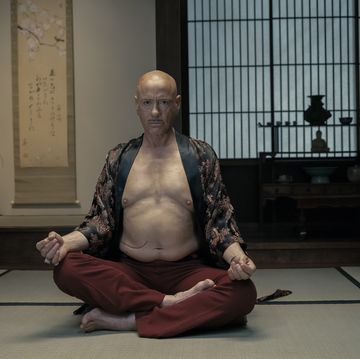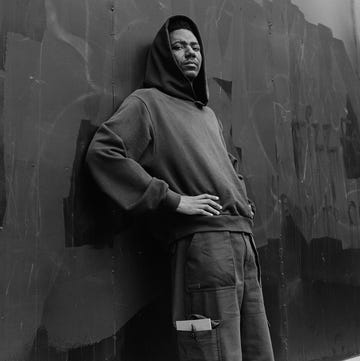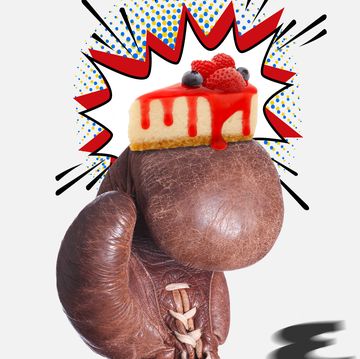Published in the October 2012 issue
On or about March 15 of this year, Teller — the smaller, quieter half of the magicians Penn & Teller — says he received an e-mail from a friend in New York. In that e-mail, the friend included a link to a video on YouTube called the Rose & Her Shadow. Teller, sitting at his computer in his Las Vegas home, within eyeshot of a large black escape cross once owned by Houdini, clicked on the link. The video lasted one minute and fifty-one seconds. "I had what I can only describe as a visceral reaction to it," Teller says today.
The video was posted by a magician who works under the stage name Gerard Bakardy; his real name is apparently Gerard Dogge. (Bakardy, a fifty-five-year-old Dutch national born in Belgium, is more than a magician; he prefers the title entertainer, because he's a musician, too. Along with his blond partner, Nadia, he was, until recently, part of a lounge act called Los Dos de Amberes, the Two from Antwerp, booked mostly in the resort of Fuerteventura on the Canary Islands off Spain. "A lovely way to spend an evening," they said in online advertisements that have since disappeared.) Leaning into his computer screen, Teller watched Bakardy perform some kind of trick.
Against a crimson curtain, Bakardy had erected an easel with what looked like a large pad of white paper on it. Perhaps six feet in front of the easel sat a small wood table bearing a glass Coke bottle filled with water. That bottle also contained a single rose. A spotlight, outside of the camera's view, cast the rose's shadow on the paper on the easel. Dressed in a dark suit, Bakardy appeared in the frame carrying a large knife in his right hand. He sliced it deep into the rose's shadow. And when he cut into its shadow, something impossible happened: The corresponding part of the rose fell off the stem and onto the table. Petal by petal, Bakardy cut at the rose's shadow until that Coke bottle somehow held only a decapitated stem, which he removed as though to demonstrate the absence of wires. He then lifted up the bottle itself — still no strings attached — and poured out the water. Ta-da.
The video ended with Bakardy's e-mail address and an offer to sell the props necessary for the Rose & Her Shadow for what turned out to be 2,450 euros, or about $3,050 at the time. In bold white type across the bottom of the screen, Bakardy left a final message for his fellow magicians, including a dumbstruck Teller: EASY TO PERFORM.
Teller is sixty-four years old; he has been a full-time magician since 1975, but he first began performing magic tricks when he was five and had nearly died. The only child of Philadelphia artists Joe and Irene Teller, he had contracted a viral infection that blossomed into a heart ailment called myocarditis. After a long stay in the hospital, he had to spend more time recuperating at home. Luckily there was a relatively new marvel called TV to occupy him, and he watched Howdy Doody, from which he ordered the Howdy Doody Magic Kit. It included a trick with a box and two lids. When Teller opened the box on one side and showed its contents to his indulgent parents, there were six tiny Mars bars; after he'd theatrically rattled it and spun it so that he could open the opposite lid, there were only three. "This is an absolute miracle I can do with my own hands," he says today in the present tense, as though no time has passed.
Because Teller performs almost entirely without speaking, his voice, strong and certain, comes as a surprise. He speaks in prose, in long, languid paragraphs peppered with literary and historical references. (He once taught high school Latin; dissatisfied with the prescribed textbook, he wrote his own.) But his round face, particularly his eyes and mouth, continue to do much of the talking for him. He is capable of great expression with just a turn of his lips, and his eyes are big and shining. They are also quick to brim with tears. "I'm more apt to cry at something beautiful than at something sad," he says.
Attempting to explain magic's hold on him, Teller invokes the psychiatrist in Equus, Martin Dysart, who tries to understand why the boy at the play's center has a blinding love of horses. A child is born into a world of phenomena all equal in their power to enslave, Dysart says. It sniffs — it sucks — it strokes its eyes over the whole uncountable range. Suddenly one strikes. Why? Moments snap together like magnets, forging a chain of shackles. Why? I can trace them. I can even, with time, pull them apart again. But why at the start they were ever magnetized at all — just those particular moments of experience and no others — I don't know.
Now Teller's voice isn't strong. He's gasping, choking on it. "I don't know," he says. "I don't know."
But for him, magic was what struck bedrock. He has dedicated his life to the distortion of reality, to trickery and benign deceit. His startling, angular house, built against a hillside in the red Nevada desert — "a poorly camouflaged military installation" is how he describes it; it's the one with the giant skull painted on the roof — is a monument to his love. Every room has a secret. His library is filled with ancient magic books, including what's considered one of the art's seminal texts, Discoverie of Witchcraft, from 1584. (It's extremely rare, because, as the story has it, King James ordered every copy burned.) One of the hallways is built in forced perspective, so it seems longer than it really is. The window that appears to be at its end is actually in the adjoining wall; a full-length 45 degree mirror explains the illusion. In the garden, there's a large bronze bear that somehow greets guests by name. The bear also does card tricks. Inside the house, Teller might hand a bewildered visitor a deck of cards and ask him to pick one before they head outside. The bear will then growl, "Was it the five of clu— no. It was the five of spades," and the bear will be right. "That one fools magicians," Teller says.
Other parts of his house reveal rather than hide. In some ways it feels like a museum in which all the exhibits have another exhibit behind them. Houdini's black escape cross? There's a small pedal tucked into its base. When Houdini pressed his bootheel against it, three sets of blades hidden in the cross's arms sliced through the ropes that bound him. Those blades still work today. Teller has a supply of rope to prove it, because he likes people to believe him.
There is a lecture about belief that Teller has given exactly four times. He has never allowed the lecture to be recorded in any way. Unless you were in the audience, it has never happened. It is called the Red Ball, after a trick he added relatively recently to Penn & Teller's Las Vegas show. Before Teller performs the trick, Penn announces to the hushed theater: "The next trick is done with a piece of thread." Teller then takes the stage, on which there is a simple bench, with a red ball and a wooden hoop in his hands. He bounces the ball. He gives it to a member of the audience to bounce. And then he drops the ball before he somehow makes it roll around the stage and back and forth along the bench, as though on command. Sometimes the ball is stuck to one of his fingers or to the small of his back; sometimes it is several feet out of his reach. He even has it jump through the hoop. All of which makes it impossible for him to be performing the Red Ball with a piece of thread. Penn must be lying. There must be something more to the trick.
In his lectures, Teller explained that the trick did not originate with him. It is based on techniques developed by a largely forgotten man named David P. Abbott, a loan shark who lived in Omaha and did magic in front of invitation-only audiences in his specially built parlor. Houdini, Kellar, Ching Ling Foo, Thurston — all the great magicians of the era made the pilgrimage to Omaha and left baffled. One of Abbott's tricks involved a golden ball that floated in the air around him. But rather than use a thread suspended from the ceiling, Abbott revealed posthumously in his Book of Mysteries, he ran the thread horizontally from his ear to the wall. By manipulating that thread with his careful hands, he could make that golden ball seem as though it were defying reality. Best of all, he could pass a hoop over it — what magicians call a prover — and eliminate a piece of thread from his audience's range of possibility, because a horizontal thread had never entered their imagination. They were looking only for the vertical.
The real point of magic, Teller said during those lectures, is "telling a beautiful lie. It lets you see what the world would be like if cause and effect weren't bound by physics." It's the collision between what you know and what you see that provides magic's greatest spark.
So Teller rigged a thread in his home library, and he put Abbott's ancient instructions on a music stand — pages that had been miraculously saved from a trash fire years before — and he went to work on making the impossible seem real. Eventually, he decided that the ball shouldn't float but roll. That would look simpler, but it would be harder. He practiced some more at a mirrored dance studio in Toronto, and at a cabin deep in the woods, and on the empty stage in Penn & Teller's theater. After every show for eighteen months, he would spend at least an hour, by himself, trying to make the Red Ball obey. ("Sometimes magic is just someone spending more time on something than anyone else might reasonably expect," Teller says.)
"I have to screw around," he told those four audiences, "to sniff the scent of an idea and track it down like a wild boar in the forest.
"It's still the hardest-to-execute piece of magic I've ever tried. In six months or a year, it will start to settle into my bones. In ten years, it'll be perfect.
"And so, what turns out to be the idea in the woods?
"I think: I'm depicting a magic trick done with a thread by using a ball that's actually alive. And I'm doing that depiction by using a piece of thread. Just one. Just a piece of thread.
"So now you know everything."
In the dusty rumble strips just outside Las Vegas, there is a man named Bill Smith who owns a company called Bill Smith's Magic Ventures. He doesn't invent tricks, but he builds them. He has built them for David Copperfield and Lance Burton and even Penn & Teller. He knows nearly all of the secrets. And one day earlier this year, while sitting behind his desk in his strange magic factory, Smith talked about the Red Ball and how much he would love to know how Teller does it. "That one has me fooled," Smith said. "There's no way he does that with a piece of thread."
But here's the truth about the Red Ball: Penn isn't lying to the audience, and neither was Teller in those four lost lectures. There is no such thing as magic. He really is doing that trick with a single piece of thread.
On or about March 22 of this year, Teller called Gerard Bakardy. They would talk many times on the phone, Teller says, and they would also exchange e-mails. Teller told Bakardy that the Rose & Her Shadow looked a little too much like a trick of his own called Shadows that he conceived when he was a teenager and has performed at nearly every one of his shows since 1975. If you saw Bakardy's version and only it, you would think that it was very good. To paraphrase Penn, it would be like hearing the Byrds play "Mr. Tambourine Man." Watching Teller performing Shadows is like hearing Dylan.
The stage is black, except for the spotlight trained on a single rose in a plain white vase, casting its shadow on a large sheet of paper clipped to an easel. Teller walks slowly toward the easel, his knife flashing. First, he cuts into the shadow of a group of leaves, and down the real leaves fall. He casts a sidelong glance at the rose. Some people laugh. He steps between the rose and the easel — unlike Bakardy, proving there are no wires before he has completed the trick — and cuts down a few more leaves, which flutter and float clear. He then finishes carving up the shadow, killing the rose in a cascade of red petals.
That's the moment when Bakardy stopped, perhaps because the trick's final act might not have been suitable for a dinner show. Teller surveys his deadly handiwork, the audience rising around him in the dark, before he "accidentally" pricks his finger with the knife. He stares at the damage he's done to himself, and then he puts his hand in front of the light, casting its shadow where the rose's used to be. A small trickle of red blood spills down the paper, as though out of his shadow, exactly where he cut himself. With a final silent flourish, Teller runs his hand over the blood, smearing it like a thick streak across a butcher's apron. And then the lights go out.
Shadows is the most elusive sort of trick, beautiful and mystifying. It's also particularly ripe for theft, because it's small and self-contained. Penn's solo tricks might involve nail guns or fire eating, and together, Penn & Teller shoot pistols and risk asphyxiating each other inside giant bags of helium. But in Teller's solo tricks, in his silent, lonely tricks, the only props might be a red ball or a single rose in a vase and a knife. When Teller is just Teller — he has legally dropped his given name, Raymond, as needless clutter — his tricks are stripped down to their glowing white cores.
It's actually Penn who best explains the power of magical restraint in his autobiography, God, No! Penn was once a student at Ringling Bros. and Barnum & Bailey Clown College in Florida. There, he learned a way to distinguish professional clowns from amateurs: the red makeup around their mouth. A professional clown stops his makeup at his top lip. He won't paint where his mustache might be, because he knows that too much makeup actually obscures his expression rather than enhances it. Amateur clowns assume that more makeup equals more expression, and they paint from the bottom of their nose to the point of their chin. Professional clowns refer to this phenomenon as the "busted asshole."
While someone like David Copperfield can fortify his grand illusions against larceny by making them too baroque and expensive to copy — to do the Appearing Car, you have to have a car, for starters — Teller has to rely on simpler defenses. In 1983, he obtained a U. S. certificate of copyright registration for Shadows. It was the first time he'd attempted anything of the sort. Teller knew that Houdini, beset by copyists, had tried to protect his tricks by writing them into one-act plays. (Pantomimes were, and remain, protected by law.) Teller wasn't seeking to defend Shadows as a magic trick, but more as a piece of performance art. His filing even included a typewritten description of the trick in which he refers to himself as "the Murderer," along with an illustration of a grinning Teller, clad entirely in black, carving up a rose by slicing into its shadow.
Until Bakardy came along, Teller had never needed his copyright filings to stake a claim. "It's not like good manners and generosity are inappropriate ways to behave in the world," he says. When he has contacted light-fingered magicians in the past, they have always apologized and stopped performing the trick. For instance, he does a trick in which he spills handfuls of coins into a tank filled with water, and they somehow turn into living, breathing goldfish. It's a throat-catching effect, and a magician in Sweden, who had seen Teller performing the trick on TV, studied the tape and finally lifted it. After Teller called him, the magician said sorry, boxed up his props in a crate, minus the fish, and shipped them to Las Vegas.
This time around, Teller offered to pay Gerard Bakardy several thousand dollars for the time he spent working on the Rose & Her Shadow. He had to promise only that he would stop performing and selling the trick. Bakardy, after asking whether Teller might help him bring Los Dos de Amberes to America, countered with a higher price. No one will confirm exactly what that amount was, but it was allegedly more than $100,000. "It really wasn't possible for me to come to any terms," Teller says. "It ended up having certain elements that reminded me of a kidnapping."
Teller, who had already persuaded YouTube to take down the offending video, asked Bakardy whether his demands were firm. Bakardy said they were.
Teller had a decision to make.
One of the greatest inventors of magic can be found inside a brick bungalow on a quiet tree-lined street in Burbank, outside Los Angeles. His name is Jim Steinmeyer. He is fifty-three years old, with silver hair and a neatly trimmed beard. In his office behind his house, he works amid towering stacks of magic books and some very worn-out tricks: the cups and balls, the linking rings, a box used to hold the woman doomed to be cut in half. (Actually, he owns two of those.) He is the man who taught David Copperfield how to make the Statue of Liberty disappear. Steinmeyer has also invented more than one hundred other illusions, many of which have become industry staples. His most famous is Origami, which he devised for Doug Henning. Copperfield also performed Origami, wearing a puffy white shirt; so did Siegfried & Roy and the Pendragons. More than one hundred magicians have legally included Origami in their acts after buying it and its secrets from the builder Steinmeyer has authorized to build it. (That builder is not Bill Smith, but Smith does build a number of Steinmeyer's inventions, including the popular Windshear, in which the performer appears to climb through the blades of a spinning fan.) At least another thousand magicians have bought knockoffs built by a man in Indiana, and a guy in Sicily, and a team of reverse engineers in China.
"Things are just out of control," Smith says. "It's the world, and it's getting worse. There have always been thieves in magic, but thievery has never been so bad as it is now. The biggest shame is, guys like Jim — Jim is retreating. I'm sure he has tons of other good ideas, but he's not making them, because it's not worth it. He's writing books instead."
"Invention is all fuzzy, sloppy stuff," Steinmeyer says. "I have patents, and I have had patents that have expired. Everything has a limited lifetime. But when a person can't make a living by coming up with new material, that's when you have to wonder about the system. I would say that over the last few years, the last ten years, it's a net zero. I'm putting as much money into it as I'm getting out."
Steinmeyer is surrounded by so many pirates, he's almost given up fighting them off. Because some venerable tricks, like the Zig-Zag Girl, have become so commonplace — much to the likely despair of its late inventor, Robert Harbin — many magicians have convinced themselves that every trick is fair game so long as they're able to crack its code. Pursuing the Origami thieves alone would be more than "a full-time job," Steinmeyer says. While his patents have provided some theoretical protection, he has never actually sued one of his robbers, because he knows how consuming and costly that grim task could be. Court cases might also require the magician to reveal too much about his trick in public, making the very act of protecting magic one of the easiest ways to destroy it.
And so, books: Among his many works, Steinmeyer wrote Hiding the Elephant, his best-selling history of magic. In it, he writes that the best tricks are a "collection of tiny lies, in words and deeds, that are stacked and arranged ingeniously." Like jokes, tricks should have little plots with a twist at the end that's both implausible and yet logical. You shouldn't see the punchline coming, but when you do see it, it makes sense. The secret to a great trick isn't really its method; the method behind most tricks is ugly and disappointing, something blunt and mechanical. (When Penn & Teller have famously exposed a trick, they've almost always invented a ridiculously poetic method and built the trick around it; by making their art seem more intricate than it is, they force the audience to assume that the rest of their tricks are equally complex. Penn & Teller's exposures are really part of an elaborate con.) What matters in magic is the idea — not just the idea, but the expression of the idea. The shadow in Shadows has nothing to do with the execution of the trick itself, but Shadows without the shadow is just a rose falling apart. The value of a trick lies mostly in how much it stokes that battle between your head and your heart, and how badly it makes you want for your heart to win.
"A great trick, like a great song, should be an inspiration," Steinmeyer says. "It should lead you to other things that are also wonderful. That's what happens in literature, and it happens in music, and it happens in art. But in magic, they don't do that. They just take it. You would hope that what you do inspires, but instead it just inspires theft."
Which means that Jim Steinmeyer has a stockpile of tricks that might never exist anywhere other than here, in his office behind his brick bungalow. "Origami was a thrill, it was wonderful, and I've seen it beaten into a bloody pulp before my eyes," he says. Bill Smith is right. Steinmeyer is still creating tricks; it's the production of them that has slowed. His invaluable green notebooks with big spiral bindings sit in a pile on his crowded desk, bursting with ideas that may remain locked away forever, because he's finally invented a pickproof safe: Nobody can steal what they can't see.
On April 11 of this year — that date is precisely known — Teller did something it seems no magician has done in decades: He became the plaintiff in a lawsuit in United States District Court to protect one of his magic tricks against theft. The defendant is Gerard Bakardy. "This is an action for copyright infringement and unfair competition under federal statutes," the Nature of Action reads. "Plaintiff seeks damages, attorneys' fees, and costs."
When Teller filed his lawsuit, it made news: ROGUE MAGICIAN IS EXPOSING OUR SECRETS!!! read the TMZ headline. Teller did not like the coverage. The publicity might have sold more tickets to the show, but it misunderstood his purpose. Most of the stories suggested that he was suing Bakardy to protect the secret of his trick, the method. "The method doesn't matter," Teller says. He has performed Shadows over the years with three different methods, seeking perfection. The first involved a web of fishing line that took a painfully long time to set up; the second version required rigid, uncomfortable choreography; the third, today's version, he has never revealed. Bakardy, who said that he had seen Penn & Teller's show, almost certainly didn't use Teller's present method. He knew only the idea and the effect it had on the audience. He felt the crackle that runs through the otherwise silent theater when Teller wields his knife; he saw that some people start to cry, little soft sobs in the dark; he heard that some people make strange noises and other people try to make noises and fail. What Bakardy stole from Teller wasn't a secret. Bakardy stole something that everybody who has ever seen Shadows already knows.
"It's a particularly great trick," Steinmeyer says. "It's beautiful and elegant. It needs no stupid patter. It needs no stupid presentation. Every one of its little surprises makes perfect sense. It has some feeling that it's bigger; it hints at things that are bigger and more interesting than the trick itself. It's three minutes long, and it's just perfect."
"It's so beautiful, I have tears in my eyes when he's finished, I really do," says the Amazing Randi. "The hush in the audience, my God, nobody breathes. I swear they're turning blue. You hardly blink. That's what makes it a very brave trick."
"Teller tapped into this idea of magical thinking," Penn says. "I see it as a reminder that this isn't the way the world works. I see it as a cautionary tale. To me, Shadows is a reminder of how happy we are that the world is the way it is."
"It's one of the top five tricks of all time," Bill Smith says. "There's no question about it."
That's what Bakardy stole from Teller: not the secret, but the magic. In his hands and in the hands of his desperate customers, Shadows risked becoming another Origami or the Zig-Zag Girl. It risked becoming ordinary, remembered for what it was only in eulogies.
But then Bakardy pulled a pretty nifty trick that was all his own. A lawsuit like Teller's has to be served to the defendant; a physical copy must be put in his hands. And over the last several months, a server has tried and failed to deliver those papers to Bakardy at addresses across Spain and Belgium. On May 8, Bakardy uploaded a video to YouTube that featured only blaring accordion music, gaudy text, and a photo of a rose in a Coke bottle. It promises a great reveal, the true story — as well as "The better than in Las Vegas trick... . " He also sent a short, cryptic e-mail declining to be interviewed for this story. ("Not now. Soon you'll see why.") That's all anybody has seen or heard of him in the months since Teller's lawsuit became public. Gerard Bakardy has vanished.
When Teller was in high school, he had a strange and pivotal teacher named D. G. Rosenbaum, an actor and magician who looked diabolical, with a black goatee and pince-nez. Rosey, as the kids called him, smoked black cigarettes and liked to crack raw eggs into his milk shakes. One snowbound afternoon, when his classroom was nearly empty, Rosey read a short story to those few students before him, including an enraptured Teller: "Enoch Soames," by Max Beerbohm, written in 1916.
In the story, Beerbohm relates the tragic tale of Soames, a dim, hopeless writer with delusions of future grandeur. In the 1890s, Beerbohm recounts, Soames made a deal with the devil: In exchange for his soul, Soames would be magically transported one hundred years into the future — to precisely 2:10 P.M. on June 3, 1997 — into the Round Reading Room at the British Museum. There, he could look at the shelves and through the catalogs and marvel at his inevitable success. When Soames makes his trip, however, he learns that time has almost erased him before the devil has had the chance. He is listed only as a fictional character in a short story by Max Beerbohm.
Thirty-four-and-a-half years after that snowy reading by his satanic-looking teacher, and accepting the large risk that he might be the only person in the world who cared about an old short story called "Enoch Soames," Teller flew to England ahead of June 3, 1997.
As it turned out, there were about a dozen people in the Round Reading Room that afternoon — a dozen people who had been so struck by that short story at some point in their lives, they too had decided to make the trip to London. There was a woman from Malibu named Sally; there was a short, stocky Spanish man; there was a slender woman wearing pale green. And at ten past two, they gasped when they saw a man appear mysteriously out of the stacks, looking confused as he scanned empty catalogs and asked
unhelpful librarians about his absence from the files. The man looked just like the Soames of Teller's teenage imagination, "a stooping, shambling person, rather tall, very pale, with longish and brownish hair," and he was dressed in precise costume, a soft black hat and a gray waterproof cape. The man did everything Enoch Soames did in Max Beerbohm's short story, floating around the pin-drop-quiet room before he once again disappeared into the shelves.
"For some reason," Sally from Malibu said, "I'm having to fight tears."
And all the while, Teller watched with a small smile on his face. He didn't tell anyone that he might have looked through hundreds of pages in casting books before he had found the perfect actor. He didn't tell anyone that he might have visited Angels & Bermans, where he had found just the right soft black hat and gone through countless gray waterproof capes. He didn't tell anyone that he might have had an inside friend who helped him stash the actor and his costume behind a hidden door in the stacks. Even when Teller later wrote about that magical afternoon for The Atlantic, he didn't confess his role. He never has.
"Taking credit for it that day would be a terrible thing — a terrible, terrible thing," Teller says. "That's answering the question that you must not answer."
Now, again, his voice leaves him. That afternoon took something close to actual sorcery, following years of anticipation and planning. But more than anything, it required a man whose love for magic is so deep he can turn deception into something beautiful.
For years, Penn & Teller sought a way to test our resistance to magic, to come up with a trick that forced us to make a conscious choice between wishes and facts. It took them more than twenty years to come up with the right trick, because they are a particularly patient brand of obsessive. They called the trick Honor System. It was an escape.
Before the show, there were two boxes waiting on the stage, which they invited members of the audience to inspect. One was clear, with a lid like a shoebox; the second, the larger one, looked like a wood crate with a hinged lid that swung open like a door. Teller climbed into the clear box — so the entire audience could see him — and then assistants put him and his box inside the wood crate and locked the crate from the outside. Houdini had done a double-box escape; it was a good trick, because it seemed impossible to push the lid off the clear box without opening the wood crate first. Someone could look at those boxes for a long time and not be able to figure them out.
Penn began his patter. He told the audience that they were about to be given a choice. Teller was going to make good his escape — there was no doubt about that, Penn said. Penn was going to start playing a song on his bass, and Teller was going to finish it on his vibraphone, done deal. The choice for the audience was whether it wanted to be mystified or informed. Keep your eyes open if you want to know the secret, Penn said. Keep your eyes closed if you want to be amazed.
Penn began to finger the strings, and on most nights, most of the people in the crowd kept their eyes open. They chose heads. (If you chose hearts, skip ahead to the next paragraph.) They saw Teller push up both the clear box's lid and the wood crate's lid with his feet — the wood crate was built with a hidden rig of pneumatic pistons so that the lid that opened like a door could also rise and fall like a levitating table. He then stepped out of the box, pushed down on the lids to close them, and began playing his vibraphone. It was an elegant little trick, simple and clean. It was an artful reveal.
But for those members of the audience who kept their eyes closed, Honor System was confounding. One moment Teller was locked inside a pair of boxes, and the next he was playing music beside his partner, Penn. There were people who went to see that show seven or eight times, and they never opened their eyes. It became a test of their personal resolve. Given a choice, they chose mystery. For them, Penn & Teller had turned magic into something more than entertainment. "Magic gives you the gift of a stone in your shoe," their magician friend Mike Close once said. In that short time between Penn's first hit on his bass and Teller's opening note on his vibraphone, magic was also an act of will.
On August 9 of this year, Teller received unusual permission from the court to serve Bakardy by e-mail and by running weekly notices in Antwerp and Fuerteventura newspapers for four consecutive weeks. The undelivered lawsuit had been hanging over him for months, and it sometimes showed on his face, these burdens of the man leading life's artists in their latest fight against life's thieves. "If he can find him and sue him and win, that would be huge for the world of magic," Bill Smith says. "It would set a precedent where there's never been one."
Nobody seems to know whether Teller's copyright filing will stand up in court. The law seeks clarity. Magic is expressly designed to be murky. Teller has requested a jury trial; whether he wins or loses could depend on how those twelve citizens see Shadows: Is it art? Is it the sort of art that one man can own?
At its recent World Championships, the Fédération Internationale des Sociétés Magiques gave Teller a special award for creativity and artistic vision. Some saw it as an unspoken show of support, a way to steel his resolve while also acknowledging that it's time for magicians to confront the kidnappers in their ranks. Even if Bakardy never answers the virtual summons, even if the lawsuit never gets settled or goes to court, maybe just the filing of it will be enough to change the order of things. Teller has sometimes told himself as much. "Nothing fools you better than the lie you tell yourself," he says.
For now, the fate of Teller's lawsuit, and of Bakardy himself, remains a mystery. The strange thing is, most of the evidence of Bakardy — the stills from his disappeared YouTube video and long-gone online advertisements, his aliases and nationality and birth date — survives only as legal exhibits in Teller's filing. Bakardy's name doesn't come up in magic forums except in reference to the lawsuit, and there are no ready accounts of anyone actually having seen him perform in those distant spots on a map. He has no known current address or phone, and anybody could be behind an e-mail. No one has any idea where he is. It's as though he's disappeared off the face of the earth, almost like poor Enoch Soames after he made his deal with the devil.
Is it possible that something beautiful, something implausible and yet logical, will emerge out of what appears to be a perfectly ordinary copyright suit? Could Teller's lawsuit be part of some incredible trick — that Gerard Bakardy is a stooge or an actor or never existed in the first place? ("The better than in Las Vegas trick..." "Not now. Soon you'll see why.") Even for someone as devoted as Teller, even for someone so good at long cons and keeping secrets, that would be an almost impossible trick. That would be the trick of a lifetime. That would be the sort of magic that would make you want to close your eyes.
--
UPDATE: On September 10, someone purporting to be Gerard Bakardy e-mailed Esquire, TMZ, Reuters, and Magic Magazine to inform them that he has filed a complaint in Belgian court against Teller for "libel, slander, defaming, fraud, extortion-blackmail, etc." He claims to be seeking damages of 8,000,000 Euros, or about $10,330,000 U.S. dollars. His email concluded, "Mr. Teller is fully informed about this, and I presume he's eager to give you more details. That's how celebrities are, they love the media spotlight, at least, that's what Mr. Teller told me."













